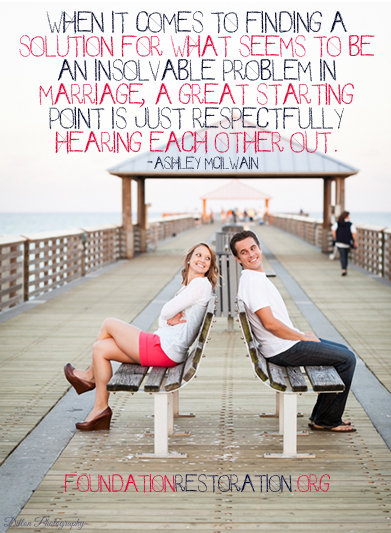By Ashley McIlwain
The other day I was having a conversation with someone about how much perspective plays into relationships, conversations, and our general approach to life. We all have a filter that we sift our observations, discussions, and interactions through, which is why no two people see things exactly the same way. That’s also why sometimes what we say and what someone hears are two different things. Perspective affects everything.
Think about it this way. Say there is an accident, and five different people witness it. The police go and speak to each witness to find out what happened. While the themes and general idea may be similar (i.e., Person A hit person B after running a stop sign), each person’s account of the situation will be completely different. Each person most likely had a different angle that they witnessed the accident from, and what seemed important to each person is probably different too. It’s not that one is right and wrong; it’s that each person saw things from a different perspective. Most likely, when all of the accounts are combined, the whole picture is then created.
Relationships are very similar. Each person has their own perspective. Each person views things from a different angle. That is why two people can feel completely right while the other views them as completely wrong.
This occurs all of the time in marriage. Each spouse is fully convinced that they are right and their other half is completely wrong. They look at each other thinking they’ve slipped into the twilight zone because this person cannot possibly really believe that they are right. Sometimes they will even say, “You are crazy!” or begin calling each other names.
The problem with this is that most likely neither spouse is completely right or wrong. Oftentimes the truth, solution, or answer lies somewhere in the middle. Combined perspectives can create one complete picture.
In the conversation I had the other day, we had two different perspectives on a few topics we discussed. The great part though was we just enjoyed dialoguing about what we thought and why. Some things we came to agree upon, and others, we agreed to disagree on. Regardless, we respected one another’s perspective and thoughts.
This “agree to disagree” concept can be a bit more difficult in marriage though because our emotions are involved. At the end of the conversation, we don’t walk away and go about our lives unscathed and relatively unaffected. No, marriage is part of who we are, so an unresolved issue can continually bring discord, frustration, and re-injury. Sometimes agreeing to disagree isn’t an option because a solution is imperative. One spouse can’t insist of having children while the other refuses. At some point, both spouses must agree upon a plan of action … a happy medium that accommodates both of their needs and desires.
The key to finding solutions for issues where spouses (or people in general) have two opposing views is appreciating and respecting the other person’s perspective. Disagreeing with someone doesn’t mean you can’t appreciate their point of view.
When it comes to finding a solution for what seems to be an insolvable problem in marriage, a great starting point is just respectfully hearing each other out. From there, you must begin to negotiate and compromise. Appreciate that the truth, the answer, lies within your two perspectives. If you want to truly find a solution, you must realize that the solution is not your answer alone; it has to accommodate both of you.

Dr. Gary Chapman says it this way, “Neither husbands nor wives can have their own way and a successful marriage at the same time.” We must bend, adjust, and adapt for our spouse. If it’s all about you, your marriage will struggle and most likely fail. Marriage requires unity, selflessness, and sacrifice.
In the example of one spouse wanting kids and one not, neither side can fully have their way. Both have to agree that there has to be a solution somewhere in the middle where both people can feel good about it. What is it? Well, maybe it’s that they will have kids, but the timeline moves from immediately to three years down the road. Or perhaps the solution is in how many children they have. The spouse who wants kids may have originally wanted four, but the one who didn’t want any would be willing to have two maximum.
Each issue has a middle ground. It’s a matter of hearing one another out, appreciating your spouse’s perspective, and being willing to work together to find a solution that accommodates both of you.
Think of children. Children, not knowing better, often throw tantrums when they want their own way. They refuse to share because they don’t want to. As parents and adults, we tell them that tantrums are not ok; that they must learn to understand they can’t always get what they want. We tell them they must learn to share because it’s necessary. The same is true for us as adults. We must learn to “share” and realize that what we want isn’t the only thing that matters. There are others in the picture that we must consider and care for. Right?
It’s easy to think our own perspective is the only one. That our perspective is fully the right one. Even if we’re 90% right, there is always room for another’s perspective. Often times that other person’s angle and perspective completes the picture like a missing piece to a puzzle. It’s like taking a 2D cartoon and making it a 3D film; we gain a new dimension, a new layer. If we approach issues and problems within our marriage, or any relationship for that matter, with this mentality, it would really change how we go about handling and resolving it.
Copyright © 2013, Foundation Restoration. ALL RIGHTS RESERVED. No reproduction allowed without written permission from Foundation Restoration and/or the author.






Way to go Ashley! Love how you make us think and grow in a good way. It isn’t too hard either…just didn’t think about it that way.
Thank you so much Linda!